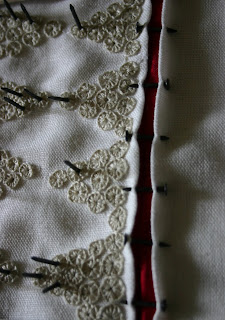
This has been a month of reflection and theoretical study; I felt misunderstood after my recent Group Crit and have felt the need to reflect on what I am trying to say in my work and how that is being read and understood by the viewer. The four embroideries I presented were read as timid explanations for a campaign against FGM, rather than a narrative around the traditions and rituals held within a culture group. The work was not well received as the issues it attempted to explore were too political and took over any aesthetic reading of the work. Having spent some time discussing my ideas I was encouraged to continue working within the framework of ritual and the sacred and to re-look at the ideas from last year around the sacraments. I also visited ‘The Sacred Made Real’ at the National Gallery and found it to be exceptionally moving and inspiring. Firstly as a religious experience the works ‘shocked my senses and stirred my soul’; the dark lighting and silence created a space in which I encountered a deeper understanding of the reality of the violence that accompanies the sacred. Secondly it confirmed the importance of the role that material and visual culture play in the spiritual journey and thereby increased my resolve to continue to explore this theme in my own practice.
My research has lead me to investigate the theories around ritual and rites of passage by firstly reading Victor Turners seminal text ‘The Ritual Process’ and his anthropological study of ritual and religion, his observations of the function of ritual and the performance element that results in a collective understanding and identity being formed by the participants. Turner challenged the traditionally accepted rational ways of thinking about religion and ritual that often disregarded the imagination or emotions such as L H Morgans view that ‘Religion deals so largely with the imaginative and emotional nature, and consequently with such uncertain elements of knowledge, that all primitive religions are grotesque and to some extent unintelligible.’ (Ancient Society 1877 p5) Turner regarded ritual as a form of non-verbal language, suggesting that rituals are spaces of meaningful symbols through which information is revealed; these symbols not only reveal religious and social values but evoke a transformation in human behavior, that those involved in the performance of a ritual are changed, transformed through their experience; the ritual performance acting as a threshold to renewed experience either in a religious or social context.
In this way Turner offers a post modern reading of ritual and religion, recognizing the importance of symbols and signs as language and encouraging a reading of the subject that is more open to experience, performance and ontological pluralism. Also Freud’s development of clinical depth-psychology has brought about a new respect for the imaginative and emotional nature of man. Understanding religious beliefs and ritual expressions are seen as important ways to understand how people and societies think and feel about relationships with one another, with a divine being, and the natural and social environments in which they function.
These ideas are feeding into my practical work; Turner suggests that ritual brings forth the unconscious into the conscious world of material thought, enabling the unknown to be understood. This is an exciting way to view the artistic act, as making visible the invisible thought.
I am beginning to ask a number of questions that will affect the outcome of my practice in relation to ritual, materiality and the sacred. For example: Do material objects hold memories or become signifiers or carriers of spiritual presence? Why are religious objects so venerated within the Catholic Church whilst denounced within Protestantism? Should we be creating new signifiers and carriers of spiritual truths or should we just replicate the old? Can video and new media replace some of these material objects? (I.e. Bill Viola, Anish Kapoor) How do we allow new media to become something special or significant within the world of material religion?
How does the material object become a signifier of the unseen world of spirit and faith ie the relic, the holy sacraments etc?
Having moved away from the Somali embroideries I want my work to be more about the ritual, the rhythm, the repetition and the belonging, I need to own up to the viewers reading of my work and readdress my subject.
I have decided to concentrate on the themes of piercing, shedding of blood, sacrifice, repetition, and the use of the red thread in ritual and rites of passage. I want to try working in video – referencing textiles in ritual practices (see work of Ann Wilson, Clio Padovani) and to think of ways of guiding the viewer to experience a sense of contemplation.


